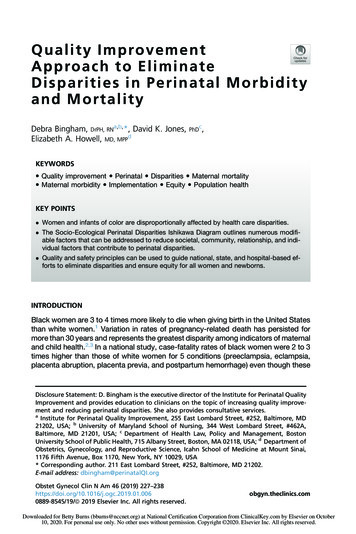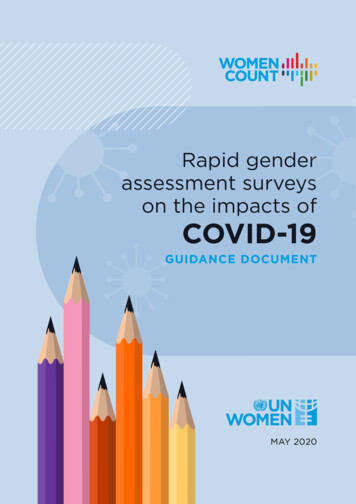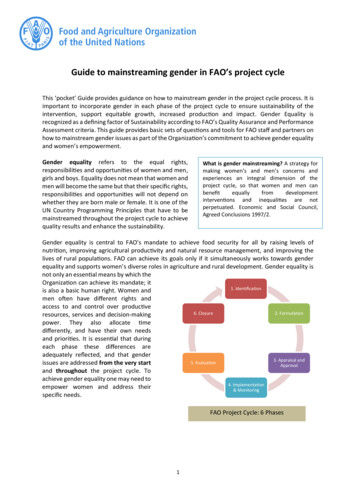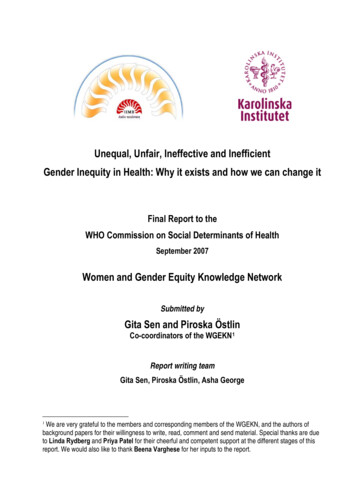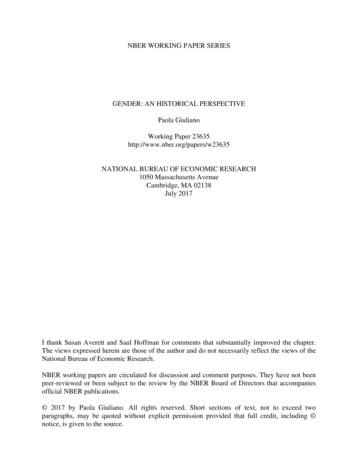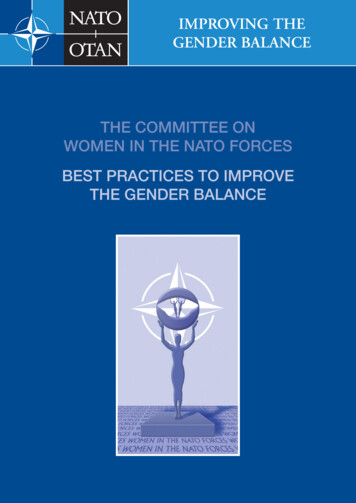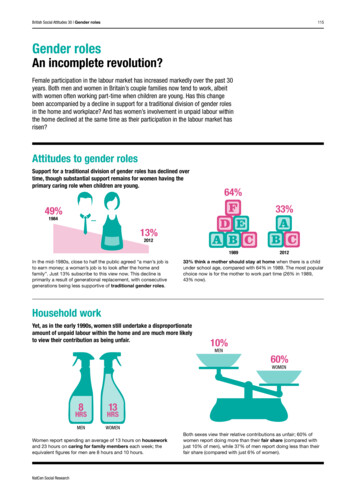
Transcription
CONCEPT PAPERGender Disparities in Academic EmergencyMedicine: Strategies for the Recruitment,Retention, and Promotion of WomenPooja Agrawal, MD, MPH1 , Tracy E. Madsen, MD, ScM2 , Michelle Lall, MD, MHS3,and Amy Zeidan, MD3ABSTRACTAlthough women comprise half of all medical students, the number of female academic emergency medicine (EM)physicians remains at approximately 27%. In addition, despite having equivalent credentials, female EM facultyremain underrecognized and undercompensated when compared to their male counterparts. Recent studies haveshown superior outcomes among patients treated by EM physicians who are women; however, disparities inadvancement persist. This white paper, prepared on behalf of the Academy for Women in Academic EmergencyMedicine, describes recent evidence demonstrating gender disparities in the EM workforce including contentpresented at the 2019 Society for Academic Emergency Medicine Annual Scientific Meeting. The authorsdescribe strategies to address the identified problems. Specific recommendations include individual as well asinstitutional/systems-level approaches to creating directed programming and initiatives to recruit, support, andpromote women at all aspects of the career continuum.The current political climate and dialogues stemming from the #MeToo movement have highlighted the ubiquitous presence of gender disparitiesacross all aspects of the workforce. Academic emergency medicine (EM) is no different. The mission ofthe Academy for Women in Academic EmergencyMedicine (AWAEM), an academy of the Society forAcademic Emergency Medicine (SAEM), includesattracting women to academic EM, providing opportunities for faculty development, leadership, and mentorship to retain and elevate women, and to developstrategies to address barriers to the advancement ofwomen in academic EM.For over two decades, roughly half of all medicalschool graduates have been women.1 Despite equalrepresentation at the medical school level, however,2019 ACGME data show a striking trend that while34.9% of EM residents are female, only 27% of EMphysicians and 16% of EM chairs are female.2 In2019, Association of American Medical Colleges(AAMC) data show that 36.2% of EM academic faculty and 12.7% of department chairs are women.3There is a pipeline problem: fewer women are choosing academic EM, and some that do will not stay inacademic EM for the length of their careers. This substantial decline in proportion of women from medicalschool to leadership positions among academic EMfaculty groups is troubling and speaks to larger issuesin the recruitment and retention of women in EM, ashas been described previously in several published articles, including Kuhn et al.4A growing body of evidence has revealed substantialgender disparities that may contribute to this lack ofretention, including gender gaps in academic rank,From the 1Yale University School of Medicine, New Haven, CT; the 2Alpert Medical School of Brown University, Providence, RI; and the 3EmoryUniversity, Atlanta, GA.Received August 29, 2019; revision received November 8, 2019; accepted November 13, 2019.The authors have no relevant financial information or potential conflicts to disclose.Author contributions: PA designed the manuscript; PA and AZ compiled and analyzed data and drafted the original manuscript; and ML and TEMprovided critical revisions of the manuscript.Supervising Editor: Wendy C. Coates, MD.Address for correspondence and reprints: Pooja Agrawal MD, MPH; e-mail: pagrawalmd@gmail.com.AEM EDUCATION AND TRAINING 2020;4:S67–S74. 2019 by the Society for Academic Emergency Medicinedoi: 10.1002/aet2.10414ISSN 2472-5390S67
S68AGRAWAL et al. STRATEGIES TO COMBAT GENDER DISPARITIES IN EMleadership positions, and salary.5 An additional theoryis that women are more likely to face career stagnationmanifested by promotion disparities. 2018 AAMCdata show a decline in female representation at eachescalating faculty rank position, from instructor(46.7%) to assistant professor (39.6%) to associate professor (28.9%) and full professor (18.1%).3,6,7 This difference in promotion is despite the fact that womenare more likely to be fellowship trained, less likely tobe core faculty, and less likely to hold administrativeroles but work similar hours as their male counterparts. Women are less likely to be chairs, vice-chairs,or emergency department directors.6 Most strikingly,even after adjusting for a comprehensive list of variables including race, region, rank, years of experience,clinical hours, core faculty status, administrative roles,board certification, and fellowship training, the meansalary for women is 19,418 less than men.6 This gender salary gap has notably remained stable over thepast few years.8The challenges described above all contribute tophysician burnout, another factor that negativelyimpacts physician retention. Female physicians in particular demonstrate higher levels and manifestations ofburnout.9–12 Female residents face gender-specific challenges in addition to the stress typically associated withresidency. They receive quantitative and qualitativeevaluations that are worse than their male counterpartsfrom both nurses and faculty.13–15 Similarly, femalefaculty receive poorer teaching evaluations from students in comparison to their male counterparts.16Female faculty and residents report higher rates of sexual harassment, gender bias, and discrimination directed from both patients and colleagues and ultimatelyhigher rates of burnout and attrition from the workforce.10,17–19 Recognizing these risk factors andaddressing disparities can help decrease burnout offemale physicians and lead to better retention.There should be little doubt that these disparitiescontribute to under recruitment, potentially poor retention and relatively less advancement of women in academic EM. Building and maintaining a diverseworkforce in EM benefits not only EM physicians, butalso patient care. For example, a 2016 study of theMedicare population showed that if male physicianshad the same outcomes as female physicians, therewould be 32,000 fewer deaths.20 Women are also twoto three times more likely to survive a heart attack iftheir doctor is a woman.21 Female physicians may confer an additional benefit to their male counterparts:the same study found that male physicians had betterpatient outcomes when there was a higher percentageof female physicians within their group.In 2008, the SAEM Task Force on Women in Academic Emergency Medicine provided recommendations for the recruitment, retention, and advancementof women in academic EM. While prior articles havemade similar recommendations and some progresshas been made, many of these recommendationsremain relevant today.4 In this report, current leadersof the AWAEM, an academy within the SAEM,review recently published literature and present a series of strategies to address and combat these pervasivedisparities.THE FRAMEWORKPrior literature has highlighted successful programmatic interventions for the advancement of women inacademic medicine.22–25 A literature review by Laverand colleagues26 summarized findings, citing 18 studies that evaluated dedicated programming for womenin academic medicine. Many programs were tailoredto women at specific career stages and most commonlyfocused on mentoring, education, and professionaldevelopment. They found that gender-specific programs at the national, institutional, and departmentallevels had positive outcomes as measured by participant satisfaction, skill acquisition, and improvement.Data on more objective outcomes, i.e., promotion andretention, were mixed, pointing to the need for furtherresearch on institutional-level strategies that wouldincrease the promotion and advancement of women.Not surprisingly, a few studies assessed educationalinterventions on gender bias in hiring practices anddemonstrated an enhanced awareness of gender biasafter program implementation.26–29 Overall, some ofthe strategies described in the literature were flawed asthey placed additional burden on individual facultyrather than targeting institutional-level strategies.As evidenced by the wide spectrum of studies includedin the review, there are many strategies to enhance therecruitment and retention of women in EM. We recommend implementing the following four concepts to guideglobal strategies: commitment to the education, management, and elimination of gender bias; affording womenwith equal access to opportunities and resources; providing leadership support and engagement; and supportingand creating a culture that strengthens work–life integration and family-friendly policies.30–32
AEM EDUCATION AND TRAINING February 2020, Vol. 4, No. S1 www.aem-e-t.comThese concepts can be implemented at institutional,departmental, and individual levels and should beadapted and refined as appropriate. Programs shouldbe tailored to the stage of each individual’s career,acknowledging that gender-specific challenges may beS69different throughout the continuum from residency toretirement. This is especially important as we considerand acknowledge the lack of equal advancement andthe departure of women from academic medicine. Asummary of recommendations is included in Table 1.Table 1Strategies for Recruitment, Retention, and Promotion of Women in EMTopic/SubtopicKey StrategiesRecruitmentMedical students- Expose students to EM early- Include female faculty in recruitment- Pair students with female mentors and arrange shadowing opportunitiesResident selection- Implement gender-blind and holistic review of applications- Enlist a diverse selection committee- Conduct regular resident demographic audits and address imbalancesResident inclusion- Develop a dedicated mentorship program between female residents and faculty- Educate faculty on gender bias in evaluations, gender neutral feedback and communication- Engage with departmental, institutional, and national female professional development organizationsHiring processes- Provide job-specific mentorship on CV building, interview techniques, and contract negotiation- Implement gender-blind evaluations and include female faculty in hiring- Discuss family-friendly policies during interviews with all applicantsRetentionCompensation-Use transparent metrics and evaluation rubrics to determine salaries and bonusesConduct regular audits to uncover differences in salaries and bonusesStandardize and audit nonfinancial or indirect compensationConsider using blinded techniques and external independent auditorsElevate any persistent pay disparities to an institutional level-Promote female faculty to leadership positions within the departmentAssign equitable value to teaching activities for those on clinical-educator trackUse transparent and standardized promotions criteriaTrack promotion rates and include female faculty on promotions committeesIdentify and support a confidential liaison to address bias-related concernsConduct periodic blind reviews of the promotion processes-Sponsor and support wellness programming within the departmentAllow faculty personal time and schedule control as neededEstablish a culture of teamwork and relationship buildingConduct periodic wellness assessments and respond to any negative findings-Provide time and resources for female faculty to travel to conferencesSupport workshops on grant/manuscript writing and public speakingGive administrative time to allow for department representationNominate female faculty for speaking opportunities, awards, editorial positionsPublicly amplify and highlight achievements of female facultyPromotionCombating burnoutFaculty developmentFamily friendly- Provide 6 to 8 weeks’ parental leave and access to FMLAPolicies- Ensure fair and transparent policies that provide adequate compensation,flexible scheduling, graduated return to work, less-than-full-time option- Offer clinical shift adjustments during and after pregnancy- Provide lactation spaces in close proximity to patient care areas- Schedule department meetings during daytime hours- Provide child/dependent care subsidies and on-site emergency care servicesProfessional- Encourage involvement by covering membership fees, travel, and providing protected time for conferencesDevelopment groups- Support the creation of a departmental PDGPDG professional development group.
S70AGRAWAL et al. STRATEGIES TO COMBAT GENDER DISPARITIES IN EMEach recommendation would be ideally supported bypositive findings from a randomized control trial; however, as this is not realistic, readers are cautioned totrial strategies to find ones that work for them and ideally study them for the benefit of others.STRATEGIES ACROSS THE CAREERCONTINUUM: PRIMING THE PIPELINEEffectively addressing the stagnation and attrition ofwomen in academic EM begins by focusing on recruitment and retention strategies for female medical studentsand residents and continues with interventions to support and retain female faculty through equity in hiring,resources, and career advancement. The ongoing attritionof female EM physicians even after the completion of agrueling residency indicates that the field has a seriousretention issue that must be investigated and slowed.Sparking Medical Student Interest in EMClosing the gap between the 50% of medical studentsand 35% of EM residents who are female will takeconcerted and directed efforts. Early exposure to EMduring medical school can help demystify the field anddemonstrate its potential as a career choice.33 Involving female faculty in medical student recruitmentwould allow future residents the opportunity to seefirsthand how female EM attendings can functionallybalance their academic, clinical, and personal lives.Residency leadership should consider deliberaterecruitment strategies such as pairing students andother trainees with female mentors and arranging forshadowing opportunities.34Resident SelectionA gender-blind review process can help remove unconscious and conscious bias from resident selection.35 Ifthat is not feasible, a holistic review of all applicationsand acknowledgment of gender bias in the review,interview, and ranking processes is important. Ensuring diverse membership and equal representation ofeach gender on the selection committee is also critical.Additionally, residency leadership should conduct regular audits of resident gender breakdown and plannedactions to address imbalances in recruitment.Resident InclusionSpecific strategies to combat female resident burnoutinclude dedicated mentorship and sponsorship programswith female faculty who could serve as potential rolemodels for young trainees.36–40 Female residents shouldbe included in conversations about wellness and combating burnout during residency. Residency and departmental leadership are encouraged to provide educationregarding feedback and communication techniquesdevoid of gender bias to faculty that focus on clinicalcompetency and to routinely identify, evaluate, and eliminate gender bias in evaluations.13,14,41 Engagement withdepartmental, institutional, and/or national female professional development groups (PDGs) provides opportunities for broadening one’s network and may helpidentify external female mentors. Finally, to ensure thatwomen continue to enter and excel in academic EM,female residents should be mentored closely during timesof transition, especially as they explore postresidencycareer options.Hiring PracticesThe transition from resident to faculty can be a challenging one to navigate on both a personal and a professional level. Women making midcareer jobtransitions also need particular consideration.42 Datahave shown that women approach contract negotiationdifferently and often less effectively than men, resulting in less optimal terms or terms that do not fullyreflect a candidate’s capabilities, achievements, orpotential.43,44 As hiring decisions are sometimes notfully transparent and subject to implicit bias, the bestway to navigate the process may not be evident. Additionally, the outcomes of an initial contract negotiationcan have a lasting impact on academic rank, promotion, clinical responsibilities, and compensation. Afirst step is to provide job-specific mentorship to seniorresidents with individualized attention and coachingon CV building, interviewing techniques, and contractnegotiation. In addition, improvements in the hiringprocess such as gender-blind evaluations and incorporating women in recruitment as well as acknowledgingthe existing biases could help.45–49 Educational interventions targeting gender bias in hiring practices havedemonstrated enhanced awareness after programimplementation. Additionally, including family-friendlypolicies in all hiring discussions regardless of gendercan benefit all applicants and indicate a culture conducive to gender equity.RETENTION STRATEGIESFewer women are rising to leadership roles within academic EM faculty groups. Disparities in compensation
AEM EDUCATION AND TRAINING February 2020, Vol. 4, No. S1 www.aem-e-t.comand promotion, burnout, and gender-based harassment all contribute to the substantial attrition ofwomen from EM. Furthermore, the challenge of finding reasonable work–life integration during thedynamic journey from parenthood to empty nestingsubstantially contributes to this attrition.50 Retentionstrategies must address these challenges.Ensure Gender Equity in CompensationFemale academic EM physicians are paid less thantheir male counterparts.51 This is the most fundamental and quantifiable of all disparities. Departmentchairs should use transparent metrics and evaluationrubrics and conduct regular audits to uncover genderbased differences in salaries and bonuses, perhapsusing blinded techniques and external independentauditors. Nonfinancial and indirect compensation,such as buy down, continuing medical educationfunds, or compensated travel, should be standardizedand audited. Finally, if disparities in pay persist, theissue should be elevated above the department chair toan institutional level.Ensure Gender Equity in PromotionAs described above, women are less likely to be promoted to associate and full professors and have leadership positions than men.51 Gender imbalances inmany areas pertinent to promotions, such as authorship, grant funding, speakerships, and participationon editorial boards, have been well documented andneed to be addressed.25,47,49,52–55 To achieve genderequity in promotion, which is often set at the institutional level, women need to be equally represented ineach of these activities. Promoting female faculty toleadership roles in the department and assigningappropriate and equitable value to teaching activitiesfor those on clinical-educator tracks can ensure parityin the process, rather than only regarding traditionallydefined metrics such as research publications andgrants as accomplishments worthy for promotion.56On a departmental level, there should be transparency and standardization of the promotions process. Departments and institutions should trackpromotion rates to evaluate for gender discrepanciesand include women on promotions committees.Departments should elect a confidential liaison toaddress and be the contact person for bias-relatedquestions or concerns. Finally, a periodic blindedreview of the promotion and recruitment processcould ensure equity.S71Foster the Development and Advancementof Female FacultyWhat is more striking than the attrition of femaleEM physicians between residency and faculty positions is how few women rise to leadership positions.There are many strategies for leadership to make aconcerted effort to promote the development andadvancement of their women faculty. Providingresources and time to allow women to travel to conferences and professional development courses canincrease their visibility and name recognition, allowopportunities for networking, and help them acquirenecessary skills to increase their chances of beingawarded gran
physicians remains at approximately 27%. In addition, despite having equivalent credentials, female EM faculty remain underrecognized and undercompensated when compared to their male counterparts. Recent studies have shown superior outcomes among patients treated by EM physicians who are women; however, disparities in advancement persist.


